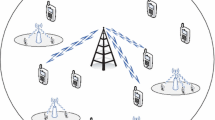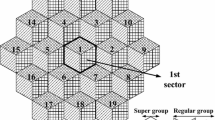Abstract
Orthogonal frequency division multiplex-based femtocell networks in downlink with two-tier interference are considered in this paper. In order to satisfy the quality of service of macrocell users, a capacity maximization problem with the total and the upper power constraints by allocating power to subcarriers for a user in femtocell systems becomes important. In this paper, the optimal power allocation is derived by using the Lagrangian technique. Based on the analysis of the Karush-Kuhn-Tucker conditions, subcarriers can be classified into two sets with different power allocation strategies according to the upper power constraint. One set of subcarriers is allocated with upper power, and the other set of subcarriers is processed by using the waterfilling approach. A direct linear search scheme is presented to achieve the optimal performance by finding the threshold over the channel states of all subcarriers to determine the two sets. In order to reduce the computational load, a reduced complexity scheme is designed for the optimal solution by utilizing the relationship of the allocated power in the two sets of subcarriers. Unlike the schemes in iterative manners, a fast power allocation scheme with a near-optimal performance is also developed. Simulation results reveal that the proposed schemes outperform the existing scheme. The efficacy of the proposed schemes is demonstrated in the simulations.
Similar content being viewed by others
References
Chowdhury M. Z., Choi S., Jang Y. M., Park K.-S., & Yoo, G. I. (2009). Dynamic SLA negotiation using bandwidth broker for femtocell networks. Paper presented at IEEE international conference on ubiquitous and future networks (pp. 12–15).
Simeone O., Erkip E., & Shamai S. (2009). Robust communication against femtocell access failures. Paper presented at IEEE information theory workshop (pp. 263–267).
Claussen H., Ho L. T. W., Samuel L. G. (2008) An overview of the femtocell concept. Bell Labs Technical Journal 13(1): 221–245
Chandrasekhar V., Andrews J. G., Gatherer A. (2008) Femtocell networks: A survey. IEEE Communications Magazine 46(9): 59–67
Roche G., la de Valcarce A., Lopez-Perez D., Zhang J. (2010) Access control mechanisms for femtocells. IEEE Communications Magazine 48(1): 33–39
Jo H.-S., Mun C., Moon J., Yook J.-G. (2009) Interference mitigation using uplink power control for two-tier femtocell networks. IEEE Transactions on Wireless Communications 8(10): 4906–4910
Choi D., Monajemi P., Kang S., & Villasenor J. (2008). Dealing with loud neighbors: the benefits and tradeoffs of adaptive femtocell access. Paper presented at IEEE global telecommunication conference (pp. 1–5).
Das D., & Ramaswamy V. (2009). Co-channel femtocell-macrocell deployments-access control. Paper presented at IEEE vehicular technology conference (pp. 1–6).
Moon J.-M., Cho D.-H. (2009) Efficient handoff algorithm for inbound mobility in hierarchical macro/femto cell networks. IEEE Communications Letters 13(10): 755–757
Chowdhury M. Z., Ryn W., Rhee E., & Jang Y. M. (2009). Handover between macrocell and femtocell for UMTS based networks. Paper presented at IEEE international conference on advanced communications technology (pp. 237–241).
Arulselvan N., Ramachandran V., Kalyanasundaram S., & Han G. (2009). Distributed power control mechanism for HSDPA femtocells. Paper presented at IEEE vehicular technology conference (pp. 1–5).
Guvenc I., Jeong M.-R., Watanabe F., Inamura H. (2008) A hybrid frequency assignment for femtocells and coverage area analysis for co-channel operation. IEEE Communications Letters 12(12): 880–882
Bai Y., Zhou J., & Chen L. (2009). Hybrid spectrum usage for overlaying LTE macrocell and femtocell. Paper presented at IEEE global telecommunications conference (pp. 1–6).
Chandrasekhar V., Andrews J. G. (2009) Spectrum allocation in tiered cellular networks. IEEE Transactions on Communications 57(10): 3059–3068
Kim T.-H. & Lee T.-J. (2008). Throughput enhancement of macro and femto networks by frequency reuse and pilot sensing. Paper presented at IEEE international performance, computing and communication conference (pp. 390–394).
Lopez-Perez D., Valcarce A., la de Roche G., Zhang J. (2009) OFDMA femtocells: A roadmap on interference avoidance. IEEE Communications Magazine 47(9): 41–48
Chandrasekhar V., Andrews J.G. (2009) Uplink capacity and interference avoidance for two-tier femtocell networks. IEEE Transactions on Wireless Communications 8(7): 3498–3509
Lopez-Perez D., de la Roche G., Valcarce A., & Zhang J. (2008). Interference avoidance and dynamic frequency planning for WiMAX femtocells networks. Paper presented at IEEE international Singapore conference on communication systems (pp. 1579–1584).
Huan S., Linling K., & Jianhua L. (2009). Interference avoidance in OFDMA-based femtocell network. Paper presented at IEEE youth conference on information, computing, and telecommunications (pp. 126–129).
Claussen H. (2007). Performance of macro- and co-channel femtocells in a hierarchical cell structure. Paper presented at IEEE international symposium on personal, indoor and mobile radio communication (pp. 1–5).
Claussen H., Ho L. T. W. & Samuel L. G. (2008) Self-optimization of coverage for femtocell deployment. Paper presented at IEEE wireless telecommunication symposium (pp. 278–285).
Lee C., Wang L. -C., & Huang J. -H. (2010). Distributed channel selection principles for femtocells with two-tier interference. Paper presented at IEEE vehicular technology conference (pp. 16–19).
Kim J.-E., Kang H.-L., Yu H.-I., Kim D., & Kim N.-M. (2009) Self-optimized power allocation based on interference cognition in femtocell network. Paper presented at IEEE VTS Asia Pacific wireless communication symposium (pp. 52–55).
Li X., Qian L., & Kateria D. (2009). Downlink power control in co-channel macrocell femtocell overlay. Paper presented at IEEE conference on information sciences and systems (pp. 383–388).
Cover T. M., Thomas J. A. (1991) Elements of information theory. Wiley, New York
Boyd S., Vandenberghe L. (2004) Convex optimization. Cambridge University Press, Cambridge
Author information
Authors and Affiliations
Corresponding author
Rights and permissions
About this article
Cite this article
Pao, WC., Chen, YF. & Chan, CY. Power Allocation Schemes in OFDM-Based Femtocell Networks. Wireless Pers Commun 69, 1165–1182 (2013). https://doi.org/10.1007/s11277-012-0626-2
Published:
Issue Date:
DOI: https://doi.org/10.1007/s11277-012-0626-2




